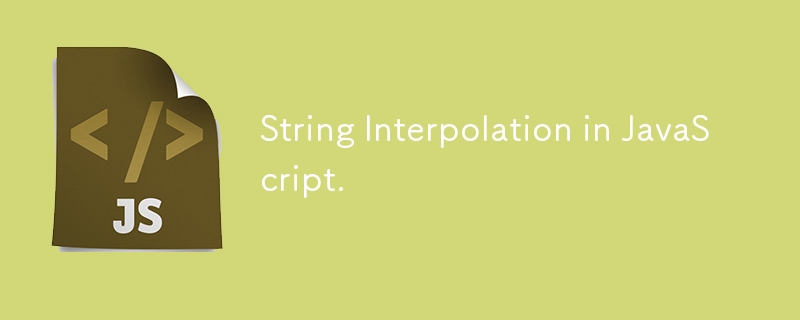JavaScript 中的字串插值。

範本文字簡介。
字串操作是程式設計中非常常見的任務,尤其是在建立互動式 Web 應用程式時。如果您曾經花時間使用 JavaScript,那麼您可能必須將一些變數放入字串中。
在舊版本的 JavaScript 中,這意味著使用運算子透過稱為 字串連接 的過程將字串連接在一起。然而,隨著 JavaScript ES6(2015) 更新中引入 範本文字 。我們現在有一種更簡潔的方法將變數插入字串,稱為 字串插值.
什麼是模板文字?
模板文字使我們能夠更輕鬆地操作字串。它們用反引號 (`) 而不是 (') 或 (") 括起來,並且它們透過使用 (${}) 語法將變數或函數呼叫直接放入字串中來支援字串插值。
這是範本文字如何簡化字串插值的範例。
const name = "John"
const age = 24
// Old method using concatenation
const greeting = "Hello, " name "! You are " age " years old."
// New method using template literals
const greetingWithTemplateLiteral = `Hello, ${name}! You are ${age} years old.`
console.log(greetingWithTemplateLiteral) // Outputs: Hello, John! You are 24 years old.
使用模板文字的好處
1. 提高可讀性
使用字串連接時,很容易迷失在一堆符號中,尤其是在處理較長的字串時。模板文字透過讓您以更容易理解的方式編寫字串來避免這種情況。
const product = "laptop"
const price = 1400
console.log(`The price of the ${product} is $${price}`)
// Outputs: The price of the laptop is $1400
2. 多行字串
在範本文字之前,您必須使用 \n 等轉義字元來產生多行字串。現在你可以將它們寫在反引號(`)中。
// Old method const multiLineString1 = "This is the first line" "\n" "This is the second line" "\n" "This is the third line" // New method const multiLineString2 = `This is the first line This is the second line This is the third line` console.log(multiLineString1) console.log(multiLineString2) /* Both output: This is the first line This is the second line This is the third line */
3. 表達式求值
您也可以執行計算、呼叫函數或操作字串內的資料。
const a = 1
const b = 10
console.log(`The sum of a and b is ${a b}`)
// Outputs: The sum of a and b is 11
const upperCaseName = (name) => name.toUpperCase()
console.log(`Your name in uppercase is ${upperCaseName("John")}`)
// Outputs: Your name in uppercase is JOHN
JavaScript 中的常見用例
1. HTML生成
您可以透過插值將變數直接放入字串中,而不是透過連接來建立 HTML 字串。
const name = "John" const htmlContent = `Hello, ${name}!
Welcome to the site.
`
2. 記錄訊息
您也可以將變數直接插入日誌訊息中,無需連線。
const user = "John"
const action = "logged in"
console.log(`User ${user} just ${action}`)
// Outputs: User John just logged in
3. 建立 URL
模板文字也讓建構 URL 變得更容易。
const userId = 123
const apiUrl = `https://api.example.com/user/${userId}/details`
console.log(apiUrl)
// Outputs: https://api.example.com/user/123/details
4. 條件邏輯
另一個很好的用例是條件邏輯。透過範本文字,您可以使用三元運算子 (? :) 為字串提供簡單條件,這是 if-else 條件的簡寫。
邏輯運算符,如 &&(與)或 || (or) 也可用於在字串中新增條件部分。這消除了額外的 if-else 語句或連接的需要。
const isMember = true
console.log(`User is ${isMember ? 'a member' : 'not a member'}`)
// Outputs: User is a member
您也可以在範本文字中加入更複雜的表達式。
/* In this example, the condition age >= 18 is evaluated
the result is either “an adult” or “a minor” based on the value of age*/
const age = 24
const message = `You are ${age >= 18 ? 'an adult' : 'a minor'}`
console.log(message)
// Outputs: You are an adult
/*In this, if isLoggedIn is true and username exists
username is displayed or else, it defaults to “Guest” */
const isLoggedIn = true
const username = "John"
const greeting = `Welcome ${isLoggedIn && username ? username : 'Guest'}`
console.log(greeting)
// Outputs: Welcome John
結論
JavaScript 中的範本文字提供了一種更清晰、更有效的方式來處理字串插值。在建立 Web 內容、記錄訊息或建立更具可讀性的程式碼之間,此方法提供了您所需的靈活性。
下次處理變數和字串時,請嘗試使用範本文字。您很快就會明白為什麼它是我使用 JavaScript 的首選方法。
資源
- MDN Web 文件 - 範本文字
- GitHub - 第一階段審查字串實驗室
- W3 學校 - JavaScript 範本字串
-
 理解 JavaScript 數組迭代方法我最近遇到一個面試問題,要求使用不同的方法來迭代 JavaScript 陣列物件。提示最初看起來很簡單,因為我需要提供一些範例程式碼片段。然而,這個問題引起了我的興趣,所以我決定更深入地研究每種方法,不僅探索如何使用它們,而且探索何時以及為何選擇一種方法而不是另一種方法。 在本文中,我將引導您了解...程式設計 發佈於2024-11-08
理解 JavaScript 數組迭代方法我最近遇到一個面試問題,要求使用不同的方法來迭代 JavaScript 陣列物件。提示最初看起來很簡單,因為我需要提供一些範例程式碼片段。然而,這個問題引起了我的興趣,所以我決定更深入地研究每種方法,不僅探索如何使用它們,而且探索何時以及為何選擇一種方法而不是另一種方法。 在本文中,我將引導您了解...程式設計 發佈於2024-11-08 -
 如何在 Galera 叢集節點上設定 MariaDB/MySQL Exporter 以進行 Prometheus 監控社群開發者您好! ? 在這篇文章中,我將引導您完成在 Galera Cluster 節點上設定 MariaDB/MySQL Exporter 以使用 Prometheus 進行監控所採取的步驟。就我而言,我在具有三個節點的雲端伺服器供應商上運行 MariaDB Galera Cluster,並使用...程式設計 發佈於2024-11-08
如何在 Galera 叢集節點上設定 MariaDB/MySQL Exporter 以進行 Prometheus 監控社群開發者您好! ? 在這篇文章中,我將引導您完成在 Galera Cluster 節點上設定 MariaDB/MySQL Exporter 以使用 Prometheus 進行監控所採取的步驟。就我而言,我在具有三個節點的雲端伺服器供應商上運行 MariaDB Galera Cluster,並使用...程式設計 發佈於2024-11-08 -
 請求 Iris 的正文限制中間件概述 Iris Body Limit 中間件是一個強大的工具,用於控制 Iris Web 應用程式中傳入請求正文的大小。透過設定請求正文的大小限制,您可以防止用戶端發送過大的負載,否則可能會壓垮您的伺服器或導致拒絕服務 (DoS) 攻擊。此中間件對於處理檔案上傳、JSON 有效負載...程式設計 發佈於2024-11-08
請求 Iris 的正文限制中間件概述 Iris Body Limit 中間件是一個強大的工具,用於控制 Iris Web 應用程式中傳入請求正文的大小。透過設定請求正文的大小限制,您可以防止用戶端發送過大的負載,否則可能會壓垮您的伺服器或導致拒絕服務 (DoS) 攻擊。此中間件對於處理檔案上傳、JSON 有效負載...程式設計 發佈於2024-11-08 -
 如何在 cookie 中儲存 PHP 陣列以及安全性和序列化的最佳實踐是什麼?在 Cookie 中儲存 PHP 陣列在 PHP 中,可以將陣列儲存在 Cookie 中,以便在後續請求時輕鬆檢索。然而,考慮安全隱患並使用正確的序列化技術至關重要。 序列化選項要將陣列轉換為cookie 相容格式,您可以選擇以下方法:JSONsetcookie('your_cookie_name'...程式設計 發佈於2024-11-08
如何在 cookie 中儲存 PHP 陣列以及安全性和序列化的最佳實踐是什麼?在 Cookie 中儲存 PHP 陣列在 PHP 中,可以將陣列儲存在 Cookie 中,以便在後續請求時輕鬆檢索。然而,考慮安全隱患並使用正確的序列化技術至關重要。 序列化選項要將陣列轉換為cookie 相容格式,您可以選擇以下方法:JSONsetcookie('your_cookie_name'...程式設計 發佈於2024-11-08 -
 如何設定VS Code調試工作目錄?設定VS Code 中偵錯的工作目錄在Visual Studio Code (VS Code) 中偵錯Python 程式時,它通常很有用指定腳本應在其中執行的工作目錄。這允許您使用與程式碼所在的特定目錄相關的檔案和資源。 要將工作目錄動態設定為目前開啟的Python 檔案的目錄,請修改launch....程式設計 發佈於2024-11-08
如何設定VS Code調試工作目錄?設定VS Code 中偵錯的工作目錄在Visual Studio Code (VS Code) 中偵錯Python 程式時,它通常很有用指定腳本應在其中執行的工作目錄。這允許您使用與程式碼所在的特定目錄相關的檔案和資源。 要將工作目錄動態設定為目前開啟的Python 檔案的目錄,請修改launch....程式設計 發佈於2024-11-08 -
 嬰兒學步學習 Laravel歡迎回來,開發者! ✨ 在Laravel 之旅的這一章中(請記住,我在撰寫這些文章時正在學習,因此這將是您能找到的最現實的教程系列之一!),我們將深入研究我們的Laravel 專案。我們將探索專案結構,熟悉遷移,並以最簡單的方式分解 MVC 架構。 ?今天的議程:...程式設計 發佈於2024-11-08
嬰兒學步學習 Laravel歡迎回來,開發者! ✨ 在Laravel 之旅的這一章中(請記住,我在撰寫這些文章時正在學習,因此這將是您能找到的最現實的教程系列之一!),我們將深入研究我們的Laravel 專案。我們將探索專案結構,熟悉遷移,並以最簡單的方式分解 MVC 架構。 ?今天的議程:...程式設計 發佈於2024-11-08 -
 如何動態包含具有不受控制的「document.write()」內容的腳本?動態新增具有不受控制的來源內容的腳本標記當內容來自於控制項外部時,建立具有外部來源的腳本標記可能會帶來挑戰包括使用document.write() 的程式碼。如前所述,僅在 中附加 script 標記無法支援此類內容。 要解決此問題,請考慮以下解決方案:使用 document.create 新建一...程式設計 發佈於2024-11-08
如何動態包含具有不受控制的「document.write()」內容的腳本?動態新增具有不受控制的來源內容的腳本標記當內容來自於控制項外部時,建立具有外部來源的腳本標記可能會帶來挑戰包括使用document.write() 的程式碼。如前所述,僅在 中附加 script 標記無法支援此類內容。 要解決此問題,請考慮以下解決方案:使用 document.create 新建一...程式設計 發佈於2024-11-08 -
 在 JavaScript 中如何有效地確定一個數字是否為素數?在 JavaScript 中高效驗證素數在電腦程式設計中,決定給定數字是否是質數是一項基本任務。質數是大於 1 的正整數,除了 1 和它本身之外沒有正因數。 檢查素數的一種流行方法涉及埃拉托斯特尼篩法。然而,出於效能考慮,可以採用更有效的方法,如以下 JavaScript 實作所示:let inpu...程式設計 發佈於2024-11-08
在 JavaScript 中如何有效地確定一個數字是否為素數?在 JavaScript 中高效驗證素數在電腦程式設計中,決定給定數字是否是質數是一項基本任務。質數是大於 1 的正整數,除了 1 和它本身之外沒有正因數。 檢查素數的一種流行方法涉及埃拉托斯特尼篩法。然而,出於效能考慮,可以採用更有效的方法,如以下 JavaScript 實作所示:let inpu...程式設計 發佈於2024-11-08 -
 為什麼 Lambda 表達式需要最終局部變數而不是實例變數?Lambda 表達式與變數作用域:為什麼Local ≠ Instance在Java 中使用lambda 表達式時,一個常見的困惑點是為什麼局部變數需要終結,而實例變數需要終結不要。本文旨在闡明這種差異背後的根本原因。 局部變數:最終性指令在 lambda 表達式中,局部變數必須標記為 Final 以...程式設計 發佈於2024-11-08
為什麼 Lambda 表達式需要最終局部變數而不是實例變數?Lambda 表達式與變數作用域:為什麼Local ≠ Instance在Java 中使用lambda 表達式時,一個常見的困惑點是為什麼局部變數需要終結,而實例變數需要終結不要。本文旨在闡明這種差異背後的根本原因。 局部變數:最終性指令在 lambda 表達式中,局部變數必須標記為 Final 以...程式設計 發佈於2024-11-08 -
 CKA 全程課程日 為什麼要使用 Kubernetes?那么,您可能已经使用 Docker 容器有一段时间了,对吧?我知道旋转第一个容器的兴奋感就像魔法一样,但随后现实袭来。您开始注意到大规模管理容器很快就会成为物流噩梦。就在那时,Kubernetes(K8s)像经验丰富的项目经理一样进入房间,准备接管并简化一切。 在这篇文章中,我们将探讨独立容器面临的...程式設計 發佈於2024-11-08
CKA 全程課程日 為什麼要使用 Kubernetes?那么,您可能已经使用 Docker 容器有一段时间了,对吧?我知道旋转第一个容器的兴奋感就像魔法一样,但随后现实袭来。您开始注意到大规模管理容器很快就会成为物流噩梦。就在那时,Kubernetes(K8s)像经验丰富的项目经理一样进入房间,准备接管并简化一切。 在这篇文章中,我们将探讨独立容器面临的...程式設計 發佈於2024-11-08 -
 適用於 AWS 雲端的簡單 SaaS 的技術堆疊介绍 注1:这里是托管的交互式演示:demo.saasconstruct.com 注 2:我每个 SaaS 设置的每月账单为 3-5 美元,其中大部分是 CI/CD 成本。 注3:模板在这里:saasconstruct.com。 我在 AWS 上完成了多个 AI PoC 和 MVP...程式設計 發佈於2024-11-08
適用於 AWS 雲端的簡單 SaaS 的技術堆疊介绍 注1:这里是托管的交互式演示:demo.saasconstruct.com 注 2:我每个 SaaS 设置的每月账单为 3-5 美元,其中大部分是 CI/CD 成本。 注3:模板在这里:saasconstruct.com。 我在 AWS 上完成了多个 AI PoC 和 MVP...程式設計 發佈於2024-11-08 -
 為什麼在事件處理程序中使用箭頭函數時「this」會出現意外行為?JavaScript - 箭頭函數與事件處理程序當使用箭頭函數作為事件處理程序的回調時,函數中的 this 值是意外的。這篇部落格文章解釋了此行為背後的原因,並提供了使用event.currentTarget.箭頭函數和詞法作用域存取預期元素的解決方案與常規函數不同,箭頭函數沒有其自己的上下文或範圍...程式設計 發佈於2024-11-08
為什麼在事件處理程序中使用箭頭函數時「this」會出現意外行為?JavaScript - 箭頭函數與事件處理程序當使用箭頭函數作為事件處理程序的回調時,函數中的 this 值是意外的。這篇部落格文章解釋了此行為背後的原因,並提供了使用event.currentTarget.箭頭函數和詞法作用域存取預期元素的解決方案與常規函數不同,箭頭函數沒有其自己的上下文或範圍...程式設計 發佈於2024-11-08 -
 Aurora PostgreSQL 掌握:讓您的團隊喜極而泣的防彈 Java 模型和 DAO听着,代码骑师。我即将提供一些知识,帮助您将 Aurora PostgreSQL 游戏从业余游戏转变为大联盟游戏。我们谈论的是 Java 模型和数据库访问器,它们会让您的高级开发人员喜极而泣,而您的 DBA 是否会给您买啤酒(取决于您的年龄)。 为什么这很重要: 性能:草率的模型和 ...程式設計 發佈於2024-11-08
Aurora PostgreSQL 掌握:讓您的團隊喜極而泣的防彈 Java 模型和 DAO听着,代码骑师。我即将提供一些知识,帮助您将 Aurora PostgreSQL 游戏从业余游戏转变为大联盟游戏。我们谈论的是 Java 模型和数据库访问器,它们会让您的高级开发人员喜极而泣,而您的 DBA 是否会给您买啤酒(取决于您的年龄)。 为什么这很重要: 性能:草率的模型和 ...程式設計 發佈於2024-11-08
學習中文
- 1 走路用中文怎麼說? 走路中文發音,走路中文學習
- 2 坐飛機用中文怎麼說? 坐飞机中文發音,坐飞机中文學習
- 3 坐火車用中文怎麼說? 坐火车中文發音,坐火车中文學習
- 4 坐車用中文怎麼說? 坐车中文發音,坐车中文學習
- 5 開車用中文怎麼說? 开车中文發音,开车中文學習
- 6 游泳用中文怎麼說? 游泳中文發音,游泳中文學習
- 7 騎自行車用中文怎麼說? 骑自行车中文發音,骑自行车中文學習
- 8 你好用中文怎麼說? 你好中文發音,你好中文學習
- 9 謝謝用中文怎麼說? 谢谢中文發音,谢谢中文學習
- 10 How to say goodbye in Chinese? 再见Chinese pronunciation, 再见Chinese learning

























